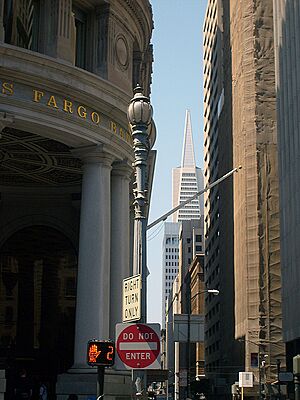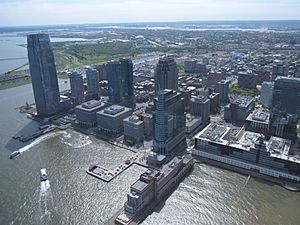Wall Street West facts for kids
Wall Street West is a special name used by people who build things, city leaders, and news reporters in the United States. It describes streets or areas west of Manhattan that have many big financial companies, like those found on Wall Street. The most famous of these places is along the waterfront in Jersey City, New Jersey.
For places in the Western United States, the name "Wall Street of the West" was used a long time ago, in the late 1800s. Montgomery Street in San Francisco is still known by this nickname today. Other places were called this for a while, but then the financial businesses moved elsewhere.
Contents
What is the "Wall Street of the West"?
This nickname describes places that became important centers for money and business, similar to how Wall Street in New York City is known.
San Francisco's Financial Hub
In the 1850s, Montgomery Street in San Francisco was mostly old wooden buildings and warehouses. But by the 1870s, new, bigger buildings were built. More and more financial companies moved there. Because of this, Montgomery Street became known as the "Wall Street of the West."
Today, the Financial District in San Francisco is much larger. It covers a big area east of Grant Avenue. In 2012, during a protest called Occupy Wall Street West, people marched through this financial district. This showed that the shorter name "Wall Street West" was also used for this important area.
Denver's Financial Street
In Denver, Colorado, the city started to get more business buildings in the late 1800s. Local leaders wanted to make Seventeenth Street the "Wall Street of Denver." An old pamphlet from 1892 promoted the Equitable Building there.
Other important buildings, like the Boston Building, were also built on 17th Street. By then, people were calling 17th Street the "Wall Street of the West." Later, it was even called "Wall Street of the Rockies" because many important financial companies came to the area.
Los Angeles's Spring Street
Los Angeles also became home to many financial companies in the early 1900s. These new financial buildings were mostly found along South Spring Street. This area was called the "Wall Street of the West," and the Spring Street Financial District was created.
This district was very busy for many years. But in the 1960s, companies started moving to other parts of downtown. By the early 1980s, many buildings on Spring Street were empty. The street no longer looked like the busy financial center it once was.
Fort Worth's Livestock Exchange
Fort Worth, Texas was also known as the "Wall Street of the West" starting in the early 1900s. But it wasn't about banks or stock trading like in other cities. In Fort Worth, the name came from trading livestock, like cows and pigs!
In 1902, the Livestock Exchange Building was built. It held many companies that bought and sold livestock. It also had offices for telegraph services and railroads. Business grew a lot, and in 1944, over 5 million animals were processed there. After that, the livestock business slowed down. The Livestock Exchange Building is now a historical site.
Jersey City: A Modern Wall Street West
In the 1980s, some financial companies began to move from Manhattan to Jersey City, New Jersey. They settled in the waterfront area, just west of the Hudson River. This area became known as "Wall Street West" after Bankers Trust moved there in 1985.
Other big financial companies followed. National Westminster Bank built a large office there. Donaldson, Lufkin & Jenrette (DLJ) moved into a new 20-story building in the Exchange Place area. A new complex called Harborside Financial Center was built, expecting even more companies to move in. Companies like Daiwa Securities, Royal Bank of Canada, and Chase Manhattan Bank planned to have many workers there.
Another big project in Exchange Place started in 1988. It was a plan to rebuild a large area where a Colgate-Palmolive soap factory used to be. The first building, 101 Hudson Street, opened in 1993. Over 3,000 back-office workers from Merrill Lynch and Lehman Brothers moved in.
On the northern side of Jersey City's waterfront, a new community called Newport began in the late 1980s. It was designed to have offices, homes, and shops. By 2001, Newport had big companies like UBS, Knight Capital, and Insurance Services Office. By this time, "Wall Street West" included the entire waterfront area, from Newport to Exchange Place.
After the September 11 attacks in 2001, financial companies became more interested in having offices outside of Manhattan. They needed places for workers who had been in Lower Manhattan. Jersey City's waterfront became very popular because it was close to Manhattan and had ferry services that were not affected by the attacks. By the end of September 2001, many large firms from the World Trade Center area, including American Express and Deutsche Bank, moved some of their work to Jersey City. Goldman Sachs even planned to move its main office to a new building in Jersey City.
However, this busy period didn't last long. By 2007, there were more empty offices. Some financial companies reduced their plans. UBS didn't fully use its new building. Goldman Sachs only partly used its building and decided to build a new main office in New York. "Wall Street West" was hit even harder by the 2008 financial crisis. Many investment banks struggled, and more offices became empty. This economic slowdown affected real estate growth in the area for several years.
As the economy slowly got better between 2011 and 2012, big companies started renting offices again. This was especially true in the Newport area, with major financial groups like Citigroup and Fidelity Investments. The Depository Trust and Clearing Corporation also moved most of its workers from Manhattan to Jersey City.
Today, jobs in "Wall Street West" make up one-third of all private jobs in Jersey City. Most of these jobs (over 60%) are in the securities industry, which deals with stocks and bonds. About 20% are in banking, and 8% are in insurance.
Northeastern Pennsylvania: A Backup Plan
After the September 11 attacks, government groups like the U.S. Securities and Exchange Commission suggested that Wall Street companies should move their data backup centers away from New York City. They wanted these centers to have different power, transportation, and water systems.
In 2006, Pennsylvania's Governor, Ed Rendell, announced a "Wall Street West" plan. The goal was to get 20 financial companies to move their backup facilities to Northeastern Pennsylvania. This area was chosen because it was about 125 miles from Manhattan. This was far enough to be safe from a major disaster but close enough for fast data transfer using fiber optic cables. The Governor promised to invest in new office buildings and better infrastructure.
The first project was the Penn Regional Business Center. An independent group called Wall Street West was created to manage the effort.
In 2007, Level 3 Communications promised $8 million for a $40 million project. This project would build a new fiber optic network from Manhattan to East Stroudsburg. This was meant to give Wall Street firms the high-speed communication they needed. However, by 2008, the plan had not attracted many Wall Street firms. Only one company, which helped financial services with rules, opened a small data center there, creating 10 jobs. Level 3 Communications said they wouldn't build the fiber optic link unless more companies committed to the area.
One problem was that many financial firms preferred to build their new data centers closer to Manhattan, within about 70 kilometers. Because of this, in 2009, the "Wall Street West" mission in Pennsylvania was changed. It now also focuses on other industries like healthcare, advanced materials, manufacturing, and transportation.



